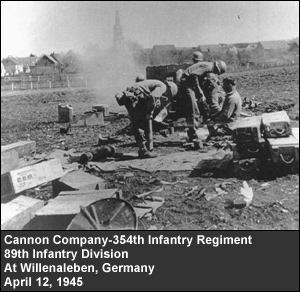 |
Central Europe: Zwikau/The End

 By April 19, all three regiments had cleared a strip east of the river some five miles deep and reached the Corps limiting line. Except for patrol action, this ended the 89th's advance in the European war, although at the time a drive either towards the Chemnitz area or southeast into Czechoslovakia was expected. For the next three weeks, the Division sent strong mechanized and foot patrols ten miles beyond the limiting line. The area included three important towns: Stollberg, Lossnitz, and Aue. Early resistance was unusually stiff but things soon quieted down and a static period followed. During this period, the combat units on patrol were rotated so that a maximum number of men had the opportunity for R&R (rest and recreation), including motion pictures, dance-band performances and a Red Cross clubmobile, operated by hostesses, which toured each outlying post at least twice. Life began to improve for most.
By April 19, all three regiments had cleared a strip east of the river some five miles deep and reached the Corps limiting line. Except for patrol action, this ended the 89th's advance in the European war, although at the time a drive either towards the Chemnitz area or southeast into Czechoslovakia was expected. For the next three weeks, the Division sent strong mechanized and foot patrols ten miles beyond the limiting line. The area included three important towns: Stollberg, Lossnitz, and Aue. Early resistance was unusually stiff but things soon quieted down and a static period followed. During this period, the combat units on patrol were rotated so that a maximum number of men had the opportunity for R&R (rest and recreation), including motion pictures, dance-band performances and a Red Cross clubmobile, operated by hostesses, which toured each outlying post at least twice. Life began to improve for most.
On April 21, a 354th task force cleared Hartenstein, killing thirty and capturing twenty-seven enemy soldiers. The following day, an air attack was made on Aue and another task force went into Neuwurschnitz, encountering stoutly defended roadblocks, small arms and Panzerfaust fire from the hills surrounding the town, and withdrew under the cover of darkness after clearing a portion of the town and returned two days later to clear the town. On May 5, the 550th Antiaircraft Battalion shot down their last German plane of the campaign, an ME-262, over the 89th's forward zone near Zwickau. During the Rhine and Central Germany campaigns, Division Artillery fired more than 21,000 rounds of ammunition. Plans for resumption of the attack early May 7 were called off when SHAEF ordered the cessation of all offensive action at 0830 and announced the unconditional surrender of the German air, sea, and ground forces. Limited to patrol action from April 19 until the German surrender, the 89ers captured over 6,500 prisoners in overcoming sometimes stiff local opposition. The Division's own newspaper, the Rolling W, printed on a captured German press, carried the news to every unit of the final capitulation under the headline: "WAR ENDS". Although the surrender did not become official until one minute past midnight May 9, the day of May 8 was VE-day. There was a feeling of thanksgiving, of satisfaction for a job well-done, and a sober realization that the war was but half-won. For most, the prospect of service in the Pacific Theater or a long period of occupation was imminent.
At the close of the campaign, the Corps commander wrote:
The rapidity of your advance on the Mulde River Line and the tactical skill with which your units were maneuvered to drive back a shifty, resisting enemy as well as to conform to the changing objectives and zones of action, were distinguished achievements.
From a green division, the Rolling W had matured into a smoothly functioning outfit with real teamwork and maneuverability. Its men had proved their courage and shown their ability.
Page 1 |
Page 2 | Page 3 |
Page 4 | Page 5 |
Page 6 | Page 7
|
 |

